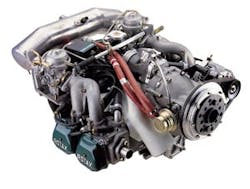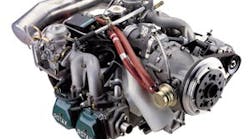Recip Technology: Waterless Engine Coolants
Has the engine temp on your antique, homebuilt, or unmanned aerial vehicles (UAVs) been running a little high lately? If it has, then Evans Cooling Systems Inc. (ECS) of Sharon, CT, (www.evanscooling.com) has something that may help.
Replenishing your engine’s conventional ethylene-glycol/water coolant with its waterless type coolant should solve your overheating problem. But before you call, you need to check out the following service bulletins by the European Aviation Safety Agency (EASA) AD 2007-0155, and FAA SAIB NE-05-84R1 to get information about coolant usage. If you have or maintain a Bombardier-Rotax (Rotax) 912 A, 912 F, 912 S, and 914 F engine, check out the Rotax service bulletins SB-912-043 Revision 2 (11/2/2006), and SB-914-029 Revision 2 (11/10/2006).
If you are aren’t operating or maintaining 912s or 914s, but still want the “down-low” on Rotax engines, go to AMTonline.com and look up the March 2009 issue, in which AMT contributor James Careless wrote an article on Rotex engines. Careless interviewed Rotax engine expert Dean Vogel of the Aero Technical Institute. In the article, Vogel is quoted as stating that, “Rotax engines are a popular choice for certified light and homebuilt aircraft, auto gyros, and military UAVs.” Rotax wanted to keep these engines light, so it took features from motorcycle and auto engines, and created engines with external oil tanks, and that use motorcycle oil and automobile grade fuel. These engines are water-cooled, which brings us back to Evans Cooling Systems Inc. and the information recommended in the EASA AD and FAA SAIB.
EASA and FAA recommendations
Sometimes OEMs and regulatory agencies act in mysterious ways that are not always apparent to us, but the reason for these service bulletins is clear. Some models of the Rotax engine have been overheating, and if you use a conventional ethylene-glycol/water coolant and your engine coolant exit temperatures exceed 120 C, you may experience a loss of coolant, engine overheating, knocking, and engine damage that can result in an in-flight shutdown. EASA addressed this overheating problem when it published the service bulletin AD 2007-0155 in which Rotax owners and operators are required to use a waterless-type coolant if their engine coolant exit temperature will exceed 120 C.
Aircraft maintenance technicians tend to be pretty cautious when it comes to using new product on our airplanes. We too have taken an oath to do no harm. More so when we are addressing a serious problem like engine-overheating, and we should be informed about waterless-type coolants. Now, if you maintain heavy-duty diesel semi-trucks or are working on a Motorcross or NASCAR pit crew, then you probably already know the waterless-type coolant, as the non-aqueous blended glycol products (NPG+, NPGR, and HDTC) produced by Evans Cooling Systems Inc.
Evans Cooling Systems Inc.
Sometimes if you work hard and persevere good things happen for you. This is the case for Jack Evans, founder of Evans Cooling Systems Inc. Evans Cooling Systems is a company that is one of the pioneers and recognized experts in cooling systems and in waterless coolants. Evans spent years in research and development to help race cars run faster without overheating and creating damage from pre-ignition knocking. His efforts paid off when he concluded that the water in the cooling system was the root cause of damage in high-performance engines. Evans quickly recognized that a substitute coolant had to be developed to progress engine design and subsequent performance. After investing several million dollars and spending years on R&D the results are the waterless coolant product line along with many patents and patent applications that cover it.
The Evans waterless coolants have boiling or vaporization points higher than conventional water-based coolants, which is what Rotax, EASA, and FAA considered when they issued their ADs and SAIBs. When using waterless coolant in your internal combustion engine, you get greater thermal efficiency, reduced detonation, and pre-ignition emissions, and reduced engine-wear with low system pressure. The radiator cap is still there but you can remove it without a gusher attacking you.
I called Mike Tourville, marketing manager for Evans, and asked him if he could explain further. I had to confess that I had never worked on water-cooled engines. My only experience with engine overheating, engine knocking, and loss of coolant was when I was driving in the White Mountains in California. I had to stop the car because the radiator boiled over and was hissing like an old steam locomotive. So, thanks to Tourville’s explanations, along with additional documents from the company’s chief engineer, Thomas Light, I was able to understand the science behind my hissing radiator. My suspicions about this involving physics was also confirmed by the document that Light sent containing short sentences and small simple words.
Limitations of water-based coolants
According to Tourville, “Nucleate Boiling” is what occurs when liquid coolant comes in direct contact with the hot metal of the engine that has reached or exceeded the boiling point of the coolant. Heat is absorbed into this layer of liquid coolant from the metal surfaces of the engine. This is a good thing because a lot of heat moves from the metal to the coolant as the coolant converts from liquid to vapor. It is not a good thing, however, if the conditions don’t exist for the vapor to readily condense back to liquid. As engine temperatures rise, the limitations of traditional water-based coolants can be quickly reached. This condition is made worse when an engine is stressed by hauling heavy loads, traveling steep grades, or in high altitudes.
The limitation is the relatively low boiling point of water. When there is very little separation between the operating temperature of the coolant and the boiling point of water, the cooling efficiency of the system declines and engine temps begin to climb. When water is boiled, it produces vapor which causes a sharp decline in effective cooling, and often the failure of the cooling system. Water vapor has almost no thermal conductivity. If the water vapor cannot condense, then you get in a loop where the water vapor makes an insulating barrier between hot metal and liquid coolant. The hot metal does not get a flow of coolant, making the temperature of the metal spike higher.
Some locations within the engine (hot spots) generate temperatures that can result in local coolant boils, creating nearly 100 percent water vapor. These hot spot results in pre-ignition (“knock”), and if this condition continues, then structural metal failure and engine shutdown can occur. I get the engine knocking part, but what about my car that turned into a hissing dragon up in the White Mountains? Again, the root cause is the boiling point of water. The boiling point of water declines as altitude increases. Just as water vapor in the cooling system can cause hot spots and engine knocking, it can also cause coolant pump cavitations when the engine is running, and create after-boil when the engine is shut down. According to the Evans experts “the action of the coolant pump creates a low pressure area at the pump inlet. Pump cavitations occurs when coolant near its boiling point encounters the low-pressure area, and flash vaporizes within the pump. The gas pocket in the pump causes the pump to stop functioning and coolant circulation to stop. Coolant pump cavitation leads directly to catastrophic cooling system failure, with the coolant being expelled from the system as steam as pressure exceeds the pressure relief setting of the cap.”
The experts also explained that after-boil occurs after shutdown of a stressed engine, when the coolant is near its boiling point, and residual heat remains in the cylinder head or in an auxiliary circuit such as an EGR cooler. “Upon shutdown the coolant pump ceases to circulate coolant through the cooling system. Residual heat boils the stagnant coolant, making steam pressure that exceeds the pressure relief setting of the cap.” Coolant is pushed out of the system, hence my hissing dragon car. Remember when I said earlier that you can operate Evans waterless coolant systems at low pressure? After learning about the limitations imposed by water-based coolants, I also wanted to know why a waterless coolant is so much more effective, and why not use it in all internal combustion engines?
Advantages of waterless coolants
Thomas Light, Evans’ chief engineer, explains, “Cooling systems using water-based coolants are operated near the boiling point of water for the pressure of the system. In contrast, an Evans waterless coolant is operated at a temperature that is much colder than its high boiling point. Consequently, condensing vapor from an Evans coolant is very easy to accomplish. Hot spots are prevented by keeping liquid coolant in contact with all of the hot metal areas all of the time.”
According to Light, tests have shown that when Evans waterless coolant is forced to operate at a temperature considerably hotter than conventional coolant temperatures, engine metal temperatures remain under control and engines are safe from detonation. Evans is up against the problem that water-based coolants have been the industry standard for more than a century. Waterless coolant is comparatively expensive because it is a proprietary product and because it is not diluted for use. However, waterless coolants provide advantages that are unavailable to water-based products and the payback period is short.
High costs for fuel and environmental concerns have focused attention on fuel economy. Tests have demonstrated that using a waterless coolant results in a significant fuel economy improvement for heavy-duty diesel engines, and by reducing fuel consumption you decrease emissions, which results in a cleaner environment. You also reduce the cost of transporting goods from coast to coast, thus making basic items like bread and milk cheaper to buy.
There is another added benefit to engine owner, operators, and maintenance technicians. Evans NPG Coolant contains ethylene glycol and also an enzyme inhibitor that acts to prevent ethylene glycol poisoning, so it is less toxic than traditional coolants. It is also a “fill and forget” fluid that is good for the life of the engine. The only time you would have to replenish the coolant is if it became contaminated with water. Sounds too good to be true?
I asked Tourville about the downside to using Evans waterless coolant, which could be the initial price point, depending on your idea of coolant cost. The highest priced Evans coolant lists for about $43.00 a gallon. But, as I am a former aviation maintenance type, that did not sound like a bunch of money for what you get. We AMTs know that aviation quality parts, tools, bits and pieces, and replenishment fluids are all expensive.
Advantages to owners and operators
The primary advantages to owners and operators are lower operating cost, and engine utility and reliability. These benefits can be gained through:
- Avoiding boil-overs
- Higher gasoline efficiency
- Reduced emissions
- Higher compression and power
- Knock reduction
- Improved octane tolerance (lower octane fuel usable)
- Reduction of hot spots (critical metal temperatures)
The primary advantages to OEMs are “fewer design limitations and weight reduction, including improved stability of engine operating temperatures, and improved aerodynamic styling. The radiator no longer needs to be higher than the engine and can be placed anywhere. Also, weight reduction is possible if higher coolant temperatures are used. Smaller radiators mean less coolant, plus the use of light-weight metals (Evans has a coolant compatible with magnesium for engines), and small cooling jackets in the engine, smaller fans.
In addition, these coolants offer faster combustion chamber metal surface warm-up, CO reduced in start-up (liners get hot faster) mostly because of the lower specific heat of waterless coolant. Finally there is the elimination of premature spark plug failure and head cracking by better cooling of head.
The primary advantages to maintainers are lower maintenance cost, safety, and waste disposal. Evans suggests that the low-pressure system reduces stresses on plumbing and that a leak would be less likely to be a spray phenomenon. The elimination of accidents resulting from accidental removal of radiator caps from hot engines is an important safety consideration too. Also frequent maintenance checks of coolant additives are eliminated, as well as the subsequent adjusting of additive levels. Finally, coolant disposal costs are reduced, if not eliminated altogether, as no coolant needs to be replaced (limits of coolant life have not yet been found). According to Tourville, vehicles have been tested up to 1,000,000 miles.
SAIB NE-05-84R1
I asked Tourville if Evans had worked with Rotax or the FAA before the SAIB recommending that owners and operators use a waterless engine coolant was issued. He said they had not. I found this interesting considering that Evans Cooling Systems Inc. owns the patent and is the only company that produces this type of coolant. It appears that Evans Cooling Systems Inc. was not aware that the FAA was preparing to issue SAIB No. NE-05-84R1.
I was curious about the process that preceded the issuance of the SAIB, so I called Richard Woldan, who was listed as the contract name on the SAIB. Woldan is an aerospace engineer at the FAA‘s Engine Certification Office, in Burlington, MA. Woldan is involved with certifying imported engines, including Rotax engines, and gave me the context for the SAIB. He had been working with his colleagues at both EASA and Rotax, and this SAIB was a continuation of the efforts of those organizations.
Neither Rotax, EASA, or the FAA worked with anyone from Evans Cooling Systems Inc. to develop the EASA AD or FAA SAIB. Their considerations were to the owners and operators of the Rotax engine, not to Evans Cooling Systems Inc. Other water-cooled engines in service include Thielert Aircraft Engines and Austro Engines. After learning about the benefits of waterless coolant I applaud the OEM and the regulatory agency staff for their due diligence. I think they made a great call when recommending the waterless coolant as a solution to the Rotax engine overheating problem.
This SAIB could be the catalyst that helps us move away from the limitations that water-based coolants place on piston engines. Not only will we see greater fuel efficiency, but the subsequent reduction in heat and pollution in both gasoline and diesel engines will certainly help the effort to reduce toxic emissions and reduce the impact on global warming. Who knew that reducing engine overheating could possibly lead to a cleaner environment? In aviation you never know where a path or a story will lead you.
Charles Chandler is an A&P based in MI. He received his training from Spartan College of Aeronautics.


